Top News

August 26, 2015 Ryukyu Shimpo
An event aimed at promoting interaction between children of different countries through nature experiences was held over five nights and six days from August 17 in the Ada district of Kunigami. On August 20, sports events were held at Ada Elementary School in the natural surrounds of Yambaru, bringing smiles to the faces of the children.
A total of 140 people took part in the event. Among them, were 74 children from Japan, South Korea, Russia, Mongolia, and China, and 66 staff including teachers from Taiwan and student volunteers from the University of the Ryukyus and Meio University. Sixteen children from Okinawa, including six pupils from Ada Elementary School, took part, and built friendships with the other children. At the farewell party, the participants took photographs of each other and exchanged T-shirts. They promised to reunite.
Most of the participants from other countries were visiting Okinawa for the first time. For the event, they stayed at a gymnasium at the school. They rode kayaks, explored an uninhabited island, and made a campfire. They enjoyed the natural environment of Yambaru.
Fourteen-year-old Marcia who enthusiastically took part in a relay at the sports festival on August 20, said, “I was impressed by the nature in Okinawa, such as the blue sea and the green mountains.” A 12-year-old Mongolian boy, Elden said, “I love the beautiful sea. I want to visit Okinawa again.” A 12-year-old Chinese boy, Liu Lee said, “I was thrilled by the exploration of the uninhabited island. I made many friends.”
Thirteen-year-old Aichi resident Ayuka Mituya, who has visited Okinawa several times for peace education programs, said, “I was surprised by the many stars in the night sky. I was able to see the Milky Way.”
A sixth grader from Jomae Elementary School Nozomi Omine said, “I could not understand their languages; however, I made friends while playing cards. It was a good experience.”
Shinobu Nakane, director of the Ryukyu branch of the Asia Association, who organized the event, said, “The participants transcended language barriers and cultural boundaries, interacting with each other. The participants, including grown-ups and children deepened their understanding of other counties.”
(English translation by T&CT)
Go to Japanese
August 23, 2015 Ryukyu Shimpo Sakae Toiyama reports from Washington D.C.
Seventy-four prominent intellectuals from the United States, Australia and other countries published a joint statement urging Okinawa Governor Takeshi Onaga to cancel his predecessor Hirokazu Nakaima’s approval of landfill in Henoko, Nago, on August 21. There, the governments of Japan and the United States are advancing construction of a new U.S. base to replace U.S. Marine Corps Air Station Futenma in Ginowan. The statement is titled, “The World is Watching: International Scholars, Artists, and Activists Petition to Prevent a New U.S. Military Base in Okinawa.”

Noam Chomsky
A third party committee for the Okinawa Prefectural Government has tabled the results of a legal report that found a flaw in the former governor’s landfill approval process.
The intellectuals, referring to the results, stressed that if the governor does not cancel the former governor’s approval, he will be complicit in an illegal process .
Their statement’s release coincided with the committee’s submission of the report and the start of an intensive, one-month consultation between the government of Tokyo and Okinawa, in which construction work for the relocation plan has been suspended.
This statement aims to pressure the governor to cancel his predecessor’s approval of the landfill.

Oliver Stone
The statement was issued under the name of prominent intellectuals, including Noam Chomsky, a famous American linguist and Oliver Stone, an Academy Award-winning film director, who both also published a statement last year opposing the Henoko relocation and asking for the immediate and unconditional return of the Futenma base .
This year, Morton Halperin, a key negotiator in the 1972 Okinawa Reversion Agreement between the United States and Japan,has become a signatory of the statement for the first time.
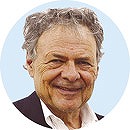
Morton Halperin
In the document, the intellectuals criticize the Japanese government, which has asserted that it will advance the construction of the new base, regardless of the result of the intensive consultation with the Okinawa Prefectural Government.
The statement highlighted that the people understand how concentrating the U.S. military bases in the prefecture amounts to structural discrimination against Okinawa. They pointed out that the governor has a legal obligation to revoke his predecessor’s approval of the landfill and respect the results of the third party’s legal report.
(English translation by T&CT)
Go to Japanese

August 20, 2015 Ryukyu Shimpo
On August 19, Christians, Buddhists, Kaminchu or Okinawan shaman and other religious people in Okinawa announced a joint statement against new security laws. “The Joint Objection Statement against Security-Related Laws” has been supported by three hundred thirty-four people so far. The statement was addressed and sent to Prime Minister Shinzo Abe and the Head of Councilors Chairman Masaaki Yamazaki. It is the first time those religious parties in Okinawa have united beyond their religious affiliations for the abolition of the bills.
On August19, Chief Priest Hirotaka Okada of Shingonshu Hasedera and Bishop Daiji Tani of the Roman Catholic Diocese of Naha said that they cannot remain silent as religious people who believe in protecting life. They said they would like to work together beyond religious differences to abolish the “war legislation.”
The statement mentioned the Battle of Okinawa and their regret that “religious people, who should have cared for the dignity of human life, supported the war.” The statement stressed the groups’ opposition to the bills. It says, 1) the forcible passage of the bills is the same tactic as forcing through the new base construction at Henoko; 2) the bills go against the Constitution.
Advocates also include Protestant Christians and Buddhists from Shingonshu Gokokuji.
For further details, call the executive committee at 098 (852) 3533.
(English translation by T&CT and Megumi Chibana)
Go to Japanese
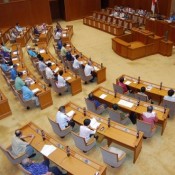
August 20, 2015 Ryukyu Shimpo
On August 12, a U.S. Army Special Operations MH-60M Black Hawk helicopter crashed on a U.S. Navy cargo vessel off the shore of Uruma City. In response, on August18, the presidents of 36 regional fisheries cooperatives making up the Okinawa Prefectural Fisheries Cooperative Presidents’ Association unanimously adopted a protest resolution demanding thorough measures toward preventing future incidents. At a general meeting held at Okinawa Fisheries Assembly Hall in Naha the same day, the president of Yonashiro Fisheries Cooperative proposed an urgent motion to address the resolution.
The resolution identifies issues with the crash site, such as its close proximity to a great number of payaos (artificial floating reefs where fish congregate), and a preferred fishing spot, which hosts the highest level of mozuku seaweed cultivation in Okinawa. It also points out that if similar incidents occur during fishing operations, the U.S. military runs the risk of aircraft crashing onto fishermen’s boats. With this resolution, the presidents’ association is calling for the Ministry of Defense and the Okinawa Defense Bureau (ODB) to put pressure on the U.S. military to prevent future accidents around Uruma.
Officials of the presidents’ association working for the prefectural fisheries cooperative intend to jointly sign the resolution, which could be written up and submitted to the ODB by the end of this month.
Kameichi Uehara, the president of the Okinawa Prefectural Fisheries Cooperative, said that the crash site was outside of the sea area provided for U.S. military training grounds, so the accident should not have occurred at all. Furthermore, he said that it is the duty of the Government of Japan to urge the U.S. military to prevent future incidents.
(English translation by T&CT and Erin Jones)
Go to Japanese
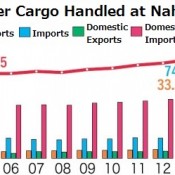
August 20, 2015 Ryukyu Shimpo
According to a preliminary estimate from the 2014 Naha Port Statistics compiled by the Naha Port Administration Management Union and released on August 19, container cargo handled at Naha Port has reached a record high of 3.927 million tons, up 3.4 percent from the previous year. However, imports and exports from overseas were only 1.083 million tons, down 1.6 percent from the previous year. This is only one tenth of the official target determined by port planners.
Furthermore, cargo exported overseas and to other parts of Japan was only 624 thousand tons, while imported cargo, at 3.303 million tons, reached more than five times that amount. These numbers show an extreme imbalance towards imports.
In 2014, ships arriving at Naha Port increased by 4.9 percent to 7,905. The total tonnage of ships also increased by 13.8 percent to a total of 24.239 million tons. Cargo ships traveling an international route reached 327, a 16.4 percent increase, while domestic cargo ships numbered 2,401, a 3.4 percent decrease.
Domestic cargo coming from and going to other Japanese ports was a total of 2.844 million tons, a 5.4 percent increase from the previous year. Of this amount, exports made up 289,000 tons, a 4.9 percent increase, while imports made up 2.555 million tons, a 5.5 percent increase. Of the 1.083 million tons of cargo directly traded with other countries, exports marked a 2.9 percent increase, reaching 334 thousand tons, while imports marked a 3.6 percent decrease, falling to 748 thousand tons.
The official Naha Port Plan, updated in 2003, aspired to making Okinawa a transshipment hub through which goods from all over Asia would pass on their way to North America over the sea route. The plan aimed for the total quantity of international cargo passing through Naha Port to reach 10.2 million tons within ten years, by the mid-2010s.
However, competition due to the rapid increase in size of many of Asia’s ports has prevented Naha Port from functioning as a transshipment hub, and now, more than ten years after the drafting of the updated Port Plan, its goals have yet to be achieved. In fact, the total amount of direct overseas imports and exports to and from Okinawa and the total quantity of international cargo (including non-container cargo) handled in Okinawa remain only slightly over 1 million tons, a level one tenth of that put forth in the Plan.
Go to Japanese

August 23, 2015 Ryukyu Shimpo
The 8th Motobu Tourism and Culture Festa, which is a popular evening event for tourism in Motobu Town, was held at a multidisciplinary events square (bull ring) on the night of August 22. Many visitors, including tourists and local people visited the event. They enjoyed Okinawan traditional culture as well as Yambaru cuisine such as acerola juice, goat soup, and tuna cheese cutlets.
Usually, Okinawan Bullfighting or UshiOrase and Goat fighting or Hijaorase are separately carried out. However, for the festa, two competitions were held on the same night. The sound of the horns of the animals colliding made a breathtaking fight for the spectators.
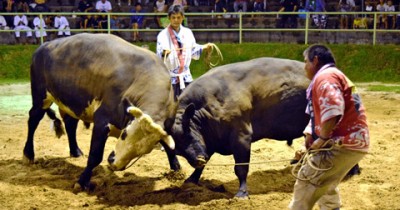
In UshiOrase, a fierce battle between two bulls provided thrills at the multidisciplinary events square (bull ring) on the night of August 22
A performance of Uechi Ryu Karate, which is said to have originated in Motobu, was given by the Motobu branch of Uechi Ryu Meada Shubu Kan. There was also an Eisa dance performance by the Toguchi Youth Association. The audience was exhilarated by the two demonstrations.
Motobu resident Harumi Nishihira, who came with her family members, including her grandchildren, said, “I came to watch the bull fights because I used to rear bulls.” Nishihira continued, “I was excited to attend the event because I know some of the bulls that took part in the competition.”
Seeing a bustling crowd of visitors at the venue, Motobu deputy Mayor Takeyasu Taira said, “I see many families. The event succeeded in providing the opportunity for town residents and tourists to interact with one another through Okinawan culture.” He went on to say, “I would like the town to further develop as a tourist spot.”
(English translation by T&CT)
Go to Japanese
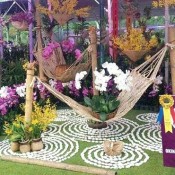
August 11, 2015 Ryukyu Shimpo
The Okinawa Churashima Foundation’s won the top honour in the display section at the Kuala Lumpur Orchid & Bonsai Show 2015. With an Okinawa-themed display, the foundation impressed judges of the International Display first prize (Kuala Lumpur Mayor’s prize).
This year is the third time the event has been held in Kuala Lumpur. Thirty pieces of work were entered from 19 other countries, including Germany and the Netherlands. The Okinawa Churashima Foundation’s winning work was its first submission to the show. Yoshihiro Hanashiro, the chairman of the Okinawa Churashima Foundation and staff members took part in an award ceremony on August 10 in Kuala Lumpur, Malaysia.
Yoshihiro Hanashiro, Atsushi Abe, researcher, and Hiroshi Furugen from Okinawa Tropical Plants Maintenance Co., Ltd. created the display together.
Taking “relaxation’ as the theme of the work, they drew ripples on the ground using white stones and they arranged kuba-gasa and Uburu into a hammock decorated with a white orchid . Kuba-gasa is a conical shape hat made of palm leaves and Uburu is a traditional Yonaguni basket made of kuba (palm leaves) used to draw water.
A person in charge of the foundation said of the prize, “This expression of Okinawa’s relaxed sense of time, which uses Okinawa’s original and traditional tools, has been acclaimed.”
(English translation by T&CT, Hitomi Shinzato)
Go to Japanese

August 17, 2015 Ryukyu Shimpo
United Nations Special Rapporteur Victoria Tauli Corpuz, who reports to the United Nations Human Rights Council and UN General Assembly UNGA, met Okinawa Governor Takeshi Onaga at the Okinawa Prefectural Office around 9 a.m. on August 17. Corpuz said that she views Okinawa as a victim of discrimination because the prefecture bears the huge burden of hosting U.S. military bases. Corpuz further stated that she would like to support Okinawa’s efforts to establish its right to self-determination as much as she possibly can.
Corpuz spoke with sit-in protesters in Henoko, Nago on August 16. She told Onaga that she was able to grasp the current atmosphere in Okinawa. Onaga explained to Corpuz the history of Okinawa and how the U.S. military built the bases in the prefecture. Onaga claimed, “Governments of Japan and the United States say that Okinawa needs to provide an alternative plan for the Henoko relocation because Marine Corps Air Station Futenma is the most dangerous air base in the world. It is an extremely unreasonable situation.”
(English translation by T&CT)
Go to Japanese
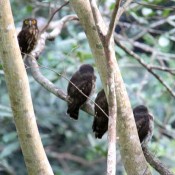
August 5, 2015 Mitsuo Kochi Correspondent of Ryukyu Shimpo
Three Ryukyu brown hawk owls born in a Nago Castle forest have taken off from their nest. The nest was submerged in the quiet and dark forest. People started to see baby owls from the beginning of July and heard them sing “chi-li-li-li”, like insects. The three baby owls stood side-by-side at first, but once they had learnt to fly, each owl roosted on branches near the nest and waited for their parents.
The owls’ parents were busy catching insects to feed the babies. Kouya Sakihama saw them during his morning walk and said, “I was worried that crows might attack the babies. I was glad to see them leaving their nest.”
Ryukyu brown hawk owls are listed as semi-endangered species on Okinawa’s red data book. The brown hawk is called Aoba zuku in Japanese. Aoba means green leafs and zuku means owl in old Japanese language. The owl is named Aoba zuku because, when green leaves start to come out, people start to see the owls.
Owls are nocturnal birds and sing, “hohho hohho”. Their bodies are about 29 centimetres long, their eyes are yellow and they have a long tail.
Kenji Takehara from Okinawa Wild Bird Research group said, “owl parents raise baby owls by feeding them insects and the babies are fledging within about 20 days. I want people to enjoy the serenity of watching the baby owls.”
(English translation by T&CT, Hitomi Shinzato)
Go to Japanese

August 15, 2015 Ryukyu Shimpo
Shinugu, which is designated as a significant intangible folk cultural asset of Japan, was held in Ada, Kunigami Village on the afternoon of August 15. In the fitful rain, local men crowned with grassy headwear and covered with leaves climbed up a mountain to become “one-day gods.” They then climbed down the mountain, driving away evil spirits, and later prayed for a rich harvest.
For shinugu, two different types of festival are carried out in alternate years. This year was the ufushinugu, the bigger festival, and next year will be the shinugungua, the smaller version.
Around noon, the men broke into groups to go into three mountains, meba, yamanasu, and sasa. They underwent a purification ceremony, sukunare, in which they became one-day gods and chanted “E-he-ho-i (yo-ho)” as they danced with a volley of bass drum rhythms and beat the ground with leaves and trees picked up from the mountains. They then marched through the village.
(English translation by T&CT)
Go to Japanese
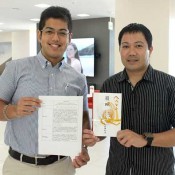
August 11, 2015 Yoshiki Nagahama of Ryukyu Shimpo
The Northern Okinawa branch of the World Youth Uchinanchu Association (WYUA) is arranging to hold a World Uchinanchu Student Summit for youth of Okinawan descent from overseas at Meio University in Nago City on November 21-22. Around forty exchange students of Okinawan descent study in Okinawa each year. This will be the first event where they will all gather together in one place.
The summit will provide opportunities for members of the Okinawan diaspora to interact and it will include time for announcements on initiatives to foster connections. Participants are expected to engage in lively discussion about how to remain connected after returning to their home countries and how to maintain and pass on their Okinawan identity. Admission is open to the general public.
Andres Higa, a third-generation Okinawan from Argentina and representative of the Northern Okinawa branch of the WYUA, and Tadashi Andres Isa, a third-generation Okinawan from Peru and vice representative of the branch, have been planning to hold a student summit for several years. Both of them have roots in the northern part of Okinawa Island.
Each city and town in Okinawa accepts exchange students of Okinawan descent, but there are few opportunities for students studying in different parts of Okinawa to interact with each other. Isa explains that he wants to use the summit as an opportunity to show that many youth of Okinawan descent are coming to study in Okinawa. Higa said exchange students who come here from all over the world are connected by Okinawa. He plans to hold the summit every year.
About 120 people are expected to attend the summit, but the organizers hope to make it even bigger if they can get enough support. For details, contact Isa at 080-4280-2406.
(Translation by T&CT and Sandi Aritza)
G0 to Japanese














 Webcam(Kokusai Street)
Webcam(Kokusai Street)


